10 Iconic Cubist Portraits
Cubism is an art movement that transformed the style in which artists expressed themselves during the 20th century. It was aimed at venturing into new and unexplored territory pertaining to depth, perception, likewise as the many dissimilar dimensions with which a viewer can perceive a single object or scene.
The fine art motion influenced everything from architecture to music and had profound, lasting impacts on the world of art every bit a whole.
While Cubism might be looked at with skepticism by the casual art enthusiast, those with deeper backgrounds in the field of fine art are able to appreciate the extent to which Cubist artists worked to portray a single object, person, or scene in a broad array of perspectives that are combined into one single work.
Cubist portraits were especially popular with the movement'south most prominent artists as the 20th century progressed.
While other art styles and movements sought to describe the human being form in a more realistic detail, Cubist painters focused on the geometric congruence that could be found in the confront and posture of an individual.
Cubist Portraits
one. Portrait of Picasso – Juan Gris
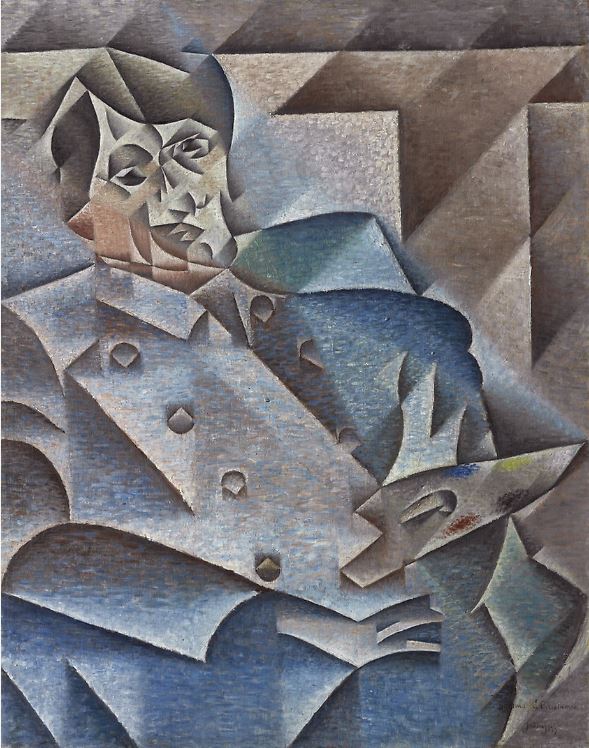
Pablo Picasso was widely considered to exist i of the founding fathers of the Cubist movement. He developed shut friendships with other painters from the catamenia, including Georges Braque and Juan Gris.
During the early on years at the commencement of the 20th century, Gris described himself to art critics and enthusiasts as "Picasso's disciple," noting that he greatly valued the new innovative style that Picasso had helped brand and then famous during the early 1900'southward.
Gris is credited with painting 1 of the most famous Cubist portraits from the time flow in his work titled Portrait of Picasso. Painted in 1912, the artist worked to portray Picasso in a mode that saw the famous artist equally a combination of simple geometric shapes.
Picasso is seen reclining in a chair, donning a blueish overcoat and calm expression. Gris wanted to pay homage to his mentor and did so by painting him with a paint palette in mitt.
He is said to take captured Picasso's calm, relaxed demeanor by using a combination of cool, blue hues throughout the entirety of the work.
2. Homo with a Guitar – Georges Braque
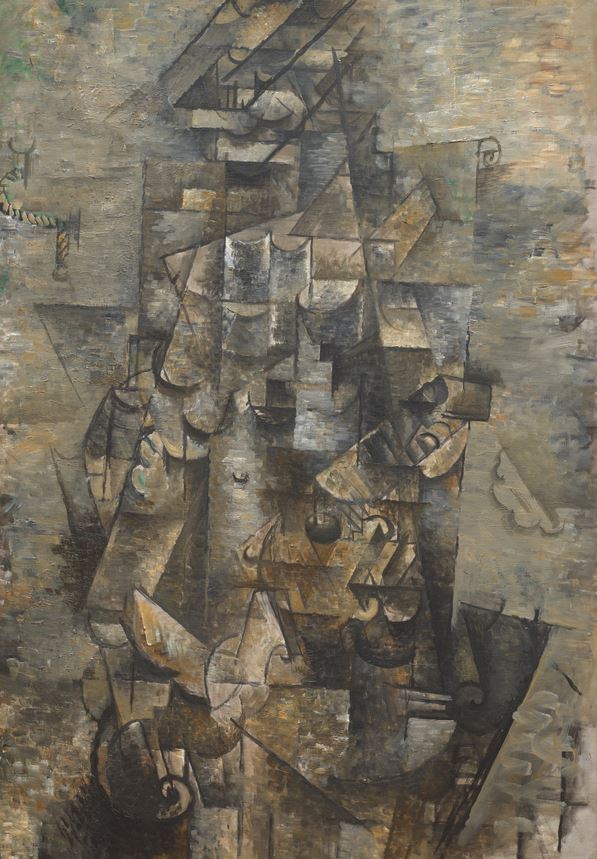
Georges Braque is noted as 1 of the most famous artists of the Cubist movement and many argue that his painting titled Man with a Guitar is arguably the most iconic work of the entire era.
Many fine art critics and historians claim that much of this painting borders forth what should be considered Analytic Cubism, merely it is even so agreed upon as being one of the most famous Cubist portraits e'er created.
Painted in 1912, during the pinnacle of the Cubist movement' ascension in European popularity, this portrait features the effigy of a man belongings a guitar.
Braque had adult a reputation equally an artist that pushed the boundaries of what is commonly considered to exist aesthetically pleasing in lodge to attain a greater piece of work that depicts the same image in a number of different perspectives and angles.
This portrait is one that depicts the same simple portrait in a way that presents the viewer with a number of dissimilar perspectives using diverse geometric components.
The darker coloration of the piece of work is part of the reason why this painting is considered to be one of the most recognizable of the Cubist motility.
3. Cubist Self-Portrait, 1923 – Salvador Dali
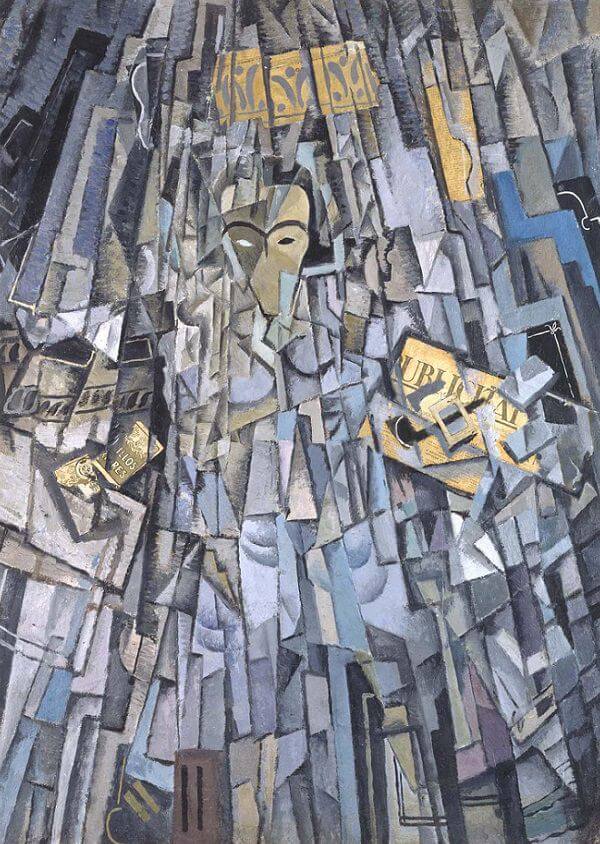
Salvador Dali is hailed equally i of the most famous artists of the 20th century every bit he is well-known for his Surrealist works and ideas. He also delved into the Cubist arena during the early on 1920'southward and created what many consider to exist a masterful work of Cubist expression.
His painting titled Cubist Self-Portrait, 1923 is 1 that is regarded as a famous work that helped further shape the Cubist movement in the mainstream art scene of the early on 20th century.
This work depicts Dali himself as a collection of fragmented, mirror-like shards that combine to give the impression of various elements of his ain advent.
Information technology is noted by art critics and historians that Dali seemed to have incorporated aspects that are fatigued from African tribal art, also every bit other areas.
iv. Portrait of Wilhelm Uhde – Pablo Picasso
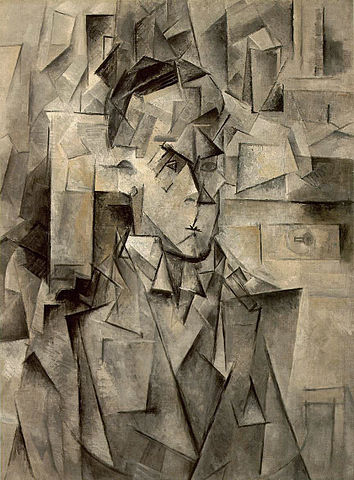
Pablo Picasso is credited equally being one of the nigh influential artists of the Cubist movement through the early 20th century. He created several portrait paintings that have get known as some of the virtually iconic works of the era.
Picasso painted 1 of his most famous portraits in 1910, which focused on the famous art collector, Wilhelm Uhde.
In his 1910 work titled Portrait of Wilhelm Uhde, Picasso depicted the collector in an assortment of shaded geometric shapes, even so the viewer is however able to clearly run into Uhde'southward figure in the painting.
The work contains a large amount of subtext, according to various fine art historians and critics while also expressing the image of Wilhelm Uhde in Picasso's usual way of bland colors that were coupled with inexpressive tones throughout the entirety of the canvas.
v. Portrait of Madame Metzinger – Jean Metzinger
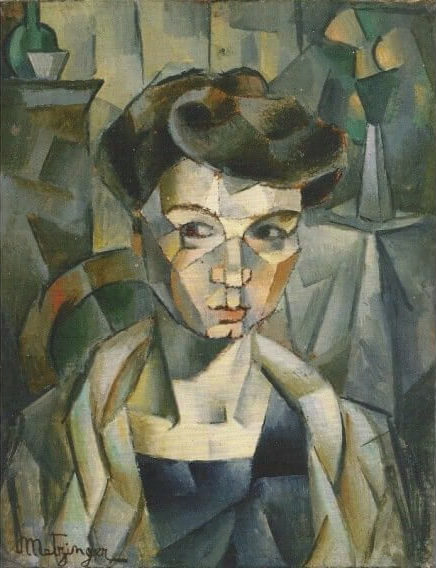
Jean Metzinger was one of the most well-known French painters of the Cubist movement. He created numerous works that are considered to exist among some of the most famous cubist paintings, but his most notable painting is arguably his work titled Portrait of Madame Metzinger.
Metzinger was known as a Renaissance man in French society during the early on 1900's and was praised for his poetry and other written work in addition to his paintings.
His portrait of Madame Metzinger was painted in 1911 and features the woman in the same usual dark coloration that is considered typical of the Cubist movement in and then many cases.
6. The Weeping Adult female – Pablo Picasso
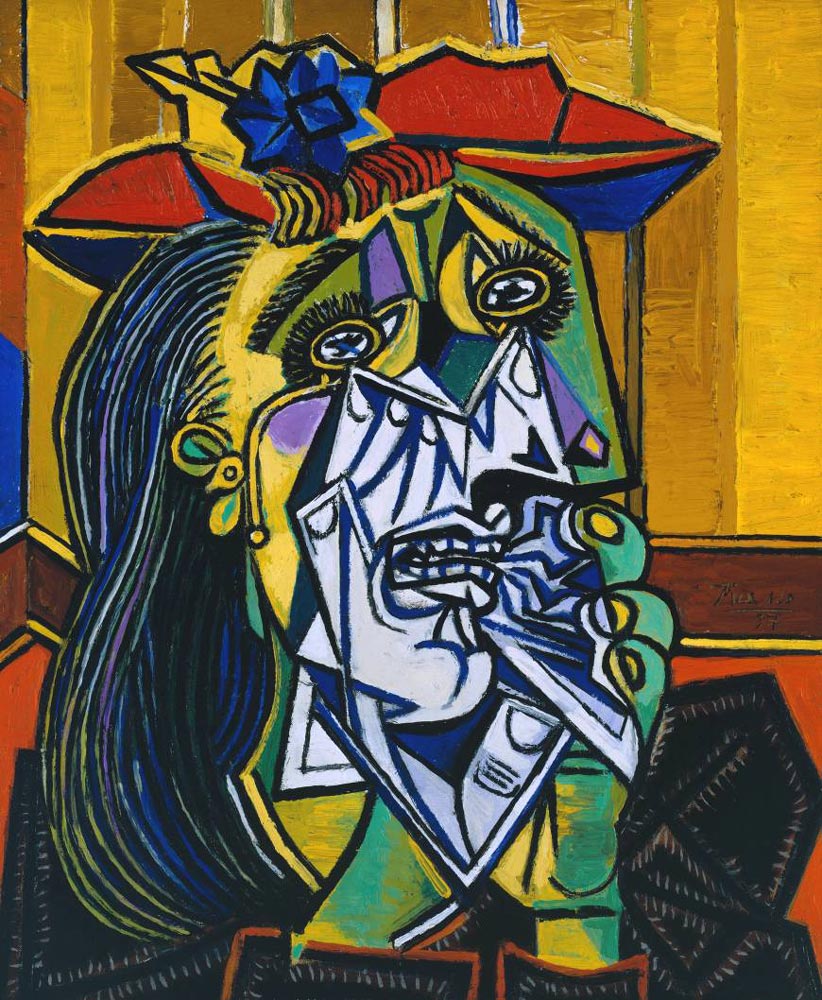
Pablo Picasso was known for his oftentimes surreal interpretations of various figures that he painted. After in his life, he began to paint in more bright colors as a way to further express the emotional significance of the subject, particularly equally it pertained to portraits such as his painting titled The Weeping Woman, which he painted in 1937.
Besides Read: Famous Pablo Picasso Paintings
This detail work features Picasso's trademarked profile view of the woman'southward confront while other minor elements hint at there being a deeper level of perspective for the viewer to see.
The piece of work largely focuses on the woman's face, which is portrayed in a wide range of contrasting colors and geometric shapes. Her high level of emotional sadness is further emphasized past Picasso'south utilise of faint bluish colors on her confront below the eyes, which seemingly indicates that her face is covered in tears.
7. Caput Of A Woman, 1909 – Georges Braque
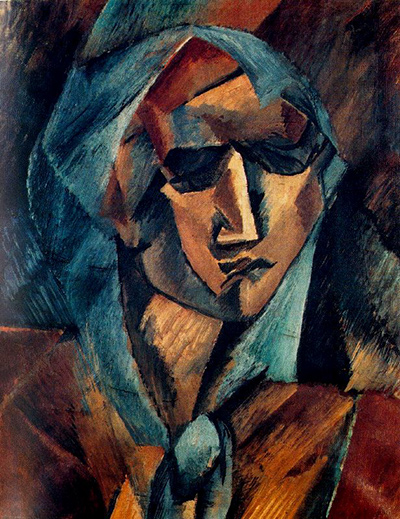
Early on in his painting career, Georges Braque experimented with a variety of different methods of portraying the human form in such a manner that might encapsulate the Cubist form of view.
His 1909 work titled Head Of A Adult female, 1909 features a woman's face and hair shrouded by nighttime bordering colors and shapes.
Braque was still truly developing his ain special brand of Cubism during this catamenia equally he painted this particular work presently after leaving art schoolhouse.
Also Read: Famous Sad Paintings
This work appears to testify Braque's deep connections with Pablo Picasso every bit it seems to describe on the same type of delineation that represents a woman's figure using long, stretching shapes. This was ane of the starting time paintings in a long series of works in which Braque portrayed the female grade using various elements of Cubism.
This particular work is known for its high level of mystery due to Braque'due south apply of darker, more hidden tones of deep blue and blackness.
Many art critics argue that the color choices of this item piece of work are direct tied to the night, dingy colors often associated with the Industrial Revolution that was sweeping the adult world at this time.
8. Femme Assise , 1909 – Pablo Picasso
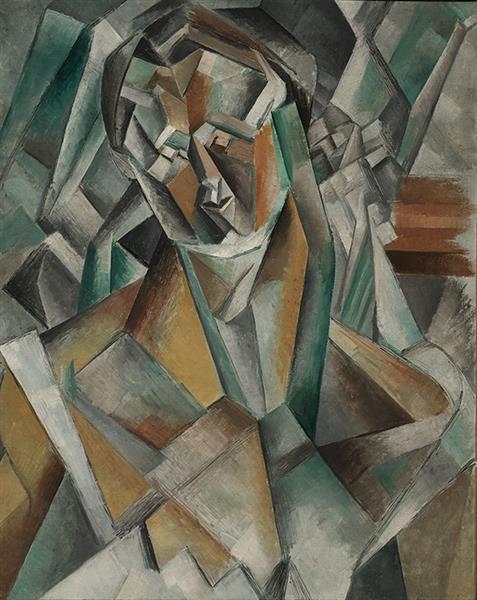
During what many consider to exist the early height of Pablo Picasso's career, he traveled to Barcelona, Spain with fellow creative person Fernande Olivier.
The events of his travels had a large impact on his overall style as many of his works after this period seem to take more than of a flair about them which many fine art historians and critics deem to be distinctly tied to Barcelona's highly unique culture and architecture.
Picasso painted i of his well-nigh famous Cubist portraits, titled Femme Assise, 1909. This item painting features a beautiful woman draped with geometric shapes which represent her pilus and figure.
This single painting is credited as one of the highlights of Picasso's career as it represented a quantum in how he represented human being class.
nine. Portrait of Josette,1916 – Juan Gris
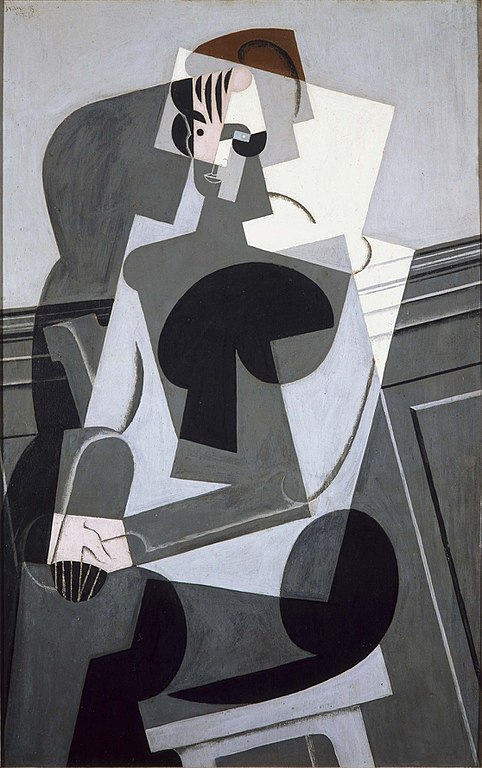
Juan Gris focused his efforts on the female form for many years in his career every bit an creative person. In 1916, the movement known as Synthetic Cubism was simply taking shape and many art critics were fixated on Gris' utilise of rounded shapes and multiple planes to represent a unmarried figure.
His 1916 work titled Portrait of Josette,1916 is among the most famous Cubist portraits ever done as it incorporates many of the emerging elements of the new variation in Cubism.
Gris depicted the woman using mostly black and white colors on a variety of levels. The woman appears to be seated in a chair, her legs folded on top of one another and her hands clasped together.
This particular work has many elements that can be traced back to the influences of Cezanne and Corot, but many art critics and historians view this equally one of his greatest masterpieces involving man form.
10. Portrait de Ambroise Vollard – Pablo Picasso
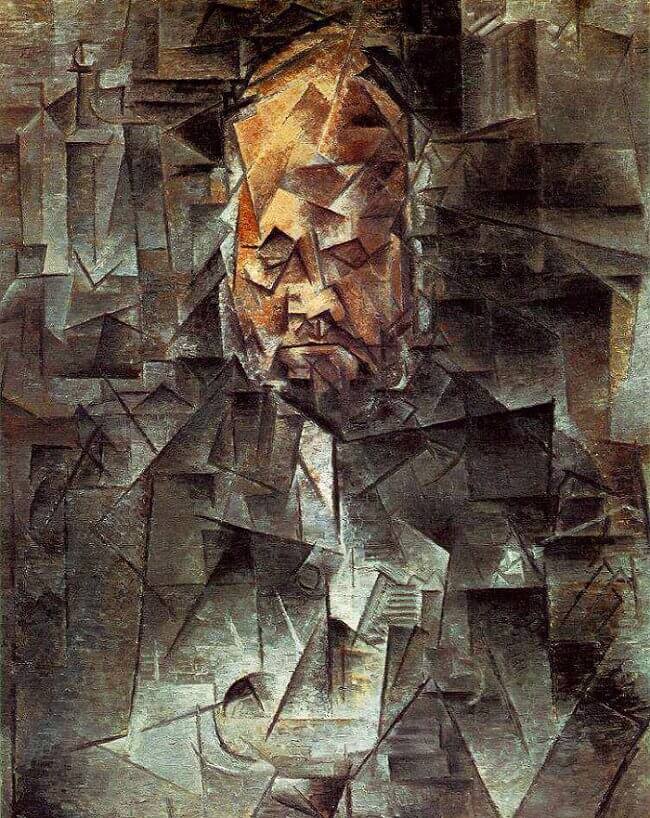
Ambroise Vollard is regarded as one of the virtually well-known art collectors of the early 20th century. He was someone that Pablo Picasso knew well and is the focus of one of the artist's nearly famous Cubist portraits ever created which is titled Portrait de Ambroise Vollard.
Created in 1910, Picasso used a variety of unique elements to combine to create a true masterpiece in the style of Cubism.
This painting features a distinctive figure, which clearly represents Vollard, who was known to have a balding caput, as well as a neatly kempt bristles.
Also Read: Paintings of Men
Picasso painted the areas outside of Vollard'due south figure with various forms of geometric shapes that intertwine to form a background of sorts.
Vollard's head seems to explode upwardly while his eyes are seen as being cast downward. Many art critics believe Picasso decided to portray the famous fine art collector in this way in an effort to indicate his bright mind and ability to distinguish nifty works of fine art.
Source: https://www.artst.org/cubist-portraits/
0 Response to "10 Iconic Cubist Portraits"
Post a Comment